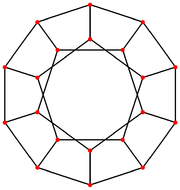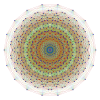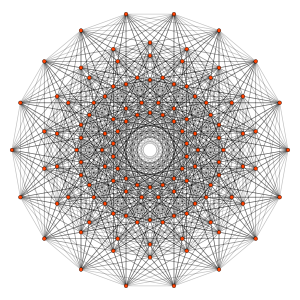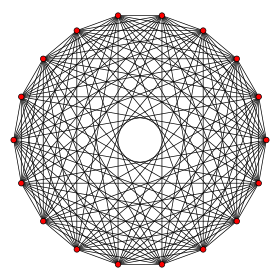Petrie polygon
In geometry, a Petrie polygon for a regular polytope of n dimensions is a skew polygon such that every (n-1) consecutive sides (but no n) belong to one of the facets. The Petrie polygon of a regular polygon is the regular polygon itself; that of a regular polyhedron is a skew polygon such that every two consecutive sides (but no three) belong to one of the faces.[1]
For every regular polytope there exists an orthogonal projection onto a plane such that one Petrie polygon becomes a regular polygon with the remainder of the projection interior to it. The plane in question is the Coxeter plane of the symmetry group of the polygon, and the number of sides, h, is Coxeter number of the Coxeter group. These polygons and projected graphs are useful in visualizing symmetric structure of the higher-dimensional regular polytopes.
History

John Flinders Petrie (1907-1972) was the only son of Egyptologist Sir W. M. Flinders Petrie. He was born in 1907 and as a schoolboy showed remarkable promise of mathematical ability. In periods of intense concentration he could answer questions about complicated four-dimensional objects by visualizing them.
He first realized the importance of the regular skew polygons which appear on the surface of regular polyhedra and higher polytopes. He was a lifelong friend of Coxeter, who named these polygons after him.
The idea of Petrie polygons was later extended to semiregular polytopes.
In 1972, a few months after his retirement, Petrie was killed by a car while attempting to cross a motorway near his home in Surrey.
The Petrie polygons of the regular polyhedra
The Petrie polygon of the regular polyhedron {p, q} has h sides, where
- cos2(π/h) = cos2(π/p) + cos2(π/q).
The regular duals, {p,q} and {q,p}, are contained within the same projected Petrie polygon.
 | ||||
| tetrahedron | cube | octahedron | dodecahedron | icosahedron |
| edge-centered | vertex-centered | face-centered | face-centered | vertex-centered |
| 4 sides | 6 sides | 6 sides | 10 sides | 10 sides |
| V:(4,0) | V:(6,2) | V:(6,0) | V:(10,10,0) | V:(10,2) |
| The Petrie polygons are the exterior of these orthogonal projections. Blue show "front" edges, while black lines show back edges. The concentric rings of vertices are counted starting from the outside working inwards with a notation: V:(a, b, ...), ending in zero if there are no central vertices. | ||||
Infinite regular skew polygons (apeirogon) can also be defined as petrie polygons of the regular tilings, having angles of 90, 120, and 60 degrees of their square, hexagon and triangular faces respectively.
Infinite regular skew polygons also exist as petrie polygons of the regular hyperbolic tilings, like the order-7 triangular tiling, {3,7}:
The Petrie polygon of regular polychora (4-polytopes)
The Petrie polygon for the regular polychora {p, q ,r} can also be determined.
 {3,3,3} 5-cell 5 sides V:(5,0) |
 {3,3,4} 16-cell 8 sides V:(8,0) |
 {4,3,3} tesseract 8 sides V:(8,8,0) |
 {3,4,3} 24-cell 12 sides V:(12,6,6,0) |
 {5,3,3} 120-cell 30 sides V:((30,60)3,603,30,60,0) |
 {3,3,5} 600-cell 30 sides V:(30,30,30,30,0) |
The Petrie polygon projections of regular and uniform polytopes
The Petrie polygon projections are most useful for visualization of polytopes of dimension four and higher. This table represents Petrie polygon projections of 3 regular families (simplex, hypercube, orthoplex), and the exceptional Lie group En which generate semiregular and uniform polytopes for dimensions 4 to 8.
| Family n |
n-simplex | n-hypercube | n-orthoplex | n-demicube | 1k2 | 2k1 | k21 | pentagonal polytope | ||||||||
|---|---|---|---|---|---|---|---|---|---|---|---|---|---|---|---|---|
| Group | An | BCn |
|
|
Hn | |||||||||||
| 2 |  |
 Square |
 p-gon (example: p=7) |
 Hexagon |
 Pentagon | |||||||||||
| 3 |  Tetrahedron |
 Cube |
 Octahedron |
 Tetrahedron |
 Dodecahedron |
 Icosahedron | ||||||||||
| 4 |  5-cell |
 |
 16-cell |
 Demitesseract |
 24-cell |
 120-cell |
 600-cell | |||||||||
| 5 |  5-simplex |
 5-cube |
 5-orthoplex |
 5-demicube |
||||||||||||
| 6 |  6-simplex |
 6-cube |
 6-orthoplex |
 6-demicube |
 122 |
 221 |
||||||||||
| 7 |  7-simplex |
 7-cube |
 7-orthoplex |
 7-demicube |
 132 |
 231 |
 321 |
|||||||||
| 8 |  8-simplex |
 8-cube |
 8-orthoplex |
 8-demicube |
 142 |
 241 |
 421 |
|||||||||
| 9 |  9-simplex |
 9-cube |
 9-orthoplex |
 9-demicube |
||||||||||||
| 10 |  10-simplex |
 10-cube |
 10-orthoplex |
 10-demicube |
||||||||||||
Petrie dual
A Petrie dual or Petrial of a regular polyhedron is a regular map whose vertices and edges correspond to the vertices and edges of the original polyhedron, and whose faces are the set of petrie polygons, and is expressed by a π superscript operator to a regular polytope. Each edge is shared by 2 petrie polygon faces.[2][3][4][5]
For example, a petrial tetrahedron, {3,3}π, has 4 vertices, 6 edges, and 3 petrie quadrilateral faces. With an Euler characteristic, χ, of 1, it is topologically identical to the hemi-cube, {4,3}/2.
The petrial cube, {4,3}π, has 8 vertices, 12 edges, and 4 petrie hexagons, colored red, green, blue and orange here. With an Euler characteristic of 0, it can also be seen in the four hexagonal faces of the toroidal hexagonal tiling {6,3}(2,0).
A petrial octahedron, {3,4}π, has 6 vertices, 12 edges, and 4 petrie hexagon faces. It has an Euler characteristic of -2, and has a mapping to the hyperbolic order-4 hexagonal tiling, as {6,4}3.
A petrial dodecahedron, {5,3}π, has 20 vertices, 30 edges, and 6 petrie decagonal faces, and Euler characteristic of -4, related to the hyperbolic tiling {10,3}5.
A petrial icosahedron, {3,6}π, has 12 vertices, 30 edges, and 6 petrie decagonal faces, and Euler characteristic of -12, related to the hyperbolic tiling {10,5}3.
| Petrial tetrahedron {3,3}π = {4,3}3 = {4,3}/2 |
Petrial cube {4,3}π = {6,3}3 = {6,3}(2,0) |
Petrial octahedron {3,4}π = {6,4}3 |
|---|---|---|
 |
 |
 |
{4,3}3 = {4,3}/2 |
 {6,3}3 = {6,3}(2,0) |
Notes
- ↑ Kaleidoscopes: Selected Writings of H. S. M. Coxeter, edited by F. Arthur Sherk, Peter McMullen, Anthony C. Thompson, Asia Ivic Weiss, Wiley-Interscience Publication, 1995, ISBN 978-0-471-01003-6 (Definition: paper 13, Discrete groups generated by reflections, 1933, p. 161)
- ↑ Abstract regular polytopes, 7B operations on regular polytopes, pp.192-200, Petrie operation, π
- ↑ http://www.weddslist.com/rmdb/pages/glossary.php#petrial
- ↑ https://www.fields.utoronto.ca/programs/scientific/11-12/discretegeom/gradcourses/Course_notes.pdf
- ↑ Coxeter–Petrie Complexes of Regular Maps
References
- Peter McMullen, Egon Schulte, Abstract Regular Polytopes, Cambridge University Press, 2002. ISBN 0-521-81496-0
- Coxeter, H. S. M. The Beauty of Geometry: Twelve Essays (1999), Dover Publications LCCN 99-35678
- Coxeter, H.S.M.; Regular complex polytopes (1974). Section 4.3 Flags and Orthoschemes, Section 11.3 Petrie polygons
- Coxeter, H. S. M. Petrie Polygons. Regular Polytopes, 3rd ed. New York: Dover, 1973. (sec 2.6 Petrie Polygons pp. 24–25, and Chapter 12, pp. 213–235, The generalized Petrie polygon )
- Coxeter, H.S.M.; Regular complex polytopes (1974).
- Ball, W. W. R. and Coxeter, H. S. M. Mathematical Recreations and Essays, 13th ed. New York: Dover, 1987. (p. 135)
External links
- Weisstein, Eric W., "Petrie polygon", MathWorld.
- Weisstein, Eric W., "Hypercube graphs", MathWorld.
- Weisstein, Eric W., "Cross polytope graphs", MathWorld.
- Weisstein, Eric W., "24-cell graph", MathWorld.
- Weisstein, Eric W., "120-cell graph", MathWorld.
- Weisstein, Eric W., "600-cell graph", MathWorld.
- Weisstein, Eric W., "Gosset graph 3_21", MathWorld.
| Fundamental convex regular and uniform polytopes in dimensions 2–10 | ||||||||||||
|---|---|---|---|---|---|---|---|---|---|---|---|---|
| Family | An | Bn | I2(p) / Dn | E6 / E7 / E8 / F4 / G2 | Hn | |||||||
| Regular polygon | Triangle | Square | p-gon | Hexagon | Pentagon | |||||||
| Uniform polyhedron | Tetrahedron | Octahedron • Cube | Demicube | Dodecahedron • Icosahedron | ||||||||
| Uniform 4-polytope | 5-cell | 16-cell • Tesseract | Demitesseract | 24-cell | 120-cell • 600-cell | |||||||
| Uniform 5-polytope | 5-simplex | 5-orthoplex • 5-cube | 5-demicube | |||||||||
| Uniform 6-polytope | 6-simplex | 6-orthoplex • 6-cube | 6-demicube | 122 • 221 | ||||||||
| Uniform 7-polytope | 7-simplex | 7-orthoplex • 7-cube | 7-demicube | 132 • 231 • 321 | ||||||||
| Uniform 8-polytope | 8-simplex | 8-orthoplex • 8-cube | 8-demicube | 142 • 241 • 421 | ||||||||
| Uniform 9-polytope | 9-simplex | 9-orthoplex • 9-cube | 9-demicube | |||||||||
| Uniform 10-polytope | 10-simplex | 10-orthoplex • 10-cube | 10-demicube | |||||||||
| Uniform n-polytope | n-simplex | n-orthoplex • n-cube | n-demicube | 1k2 • 2k1 • k21 | n-pentagonal polytope | |||||||
| Topics: Polytope families • Regular polytope • List of regular polytopes | ||||||||||||







